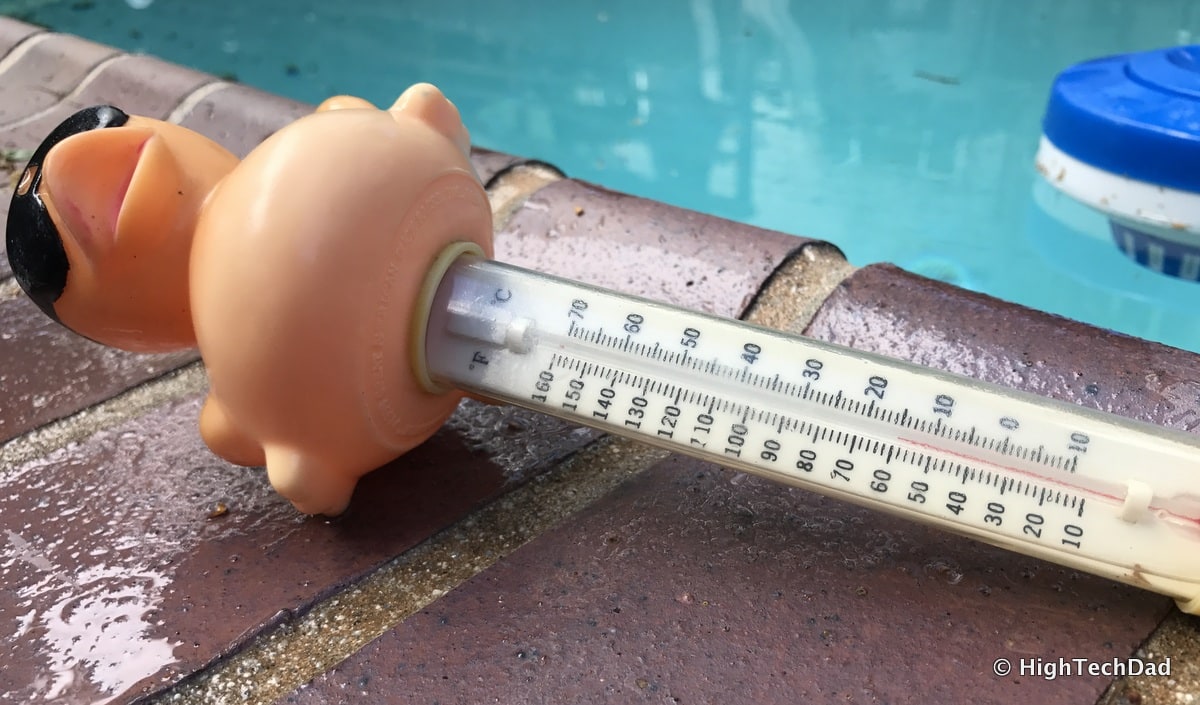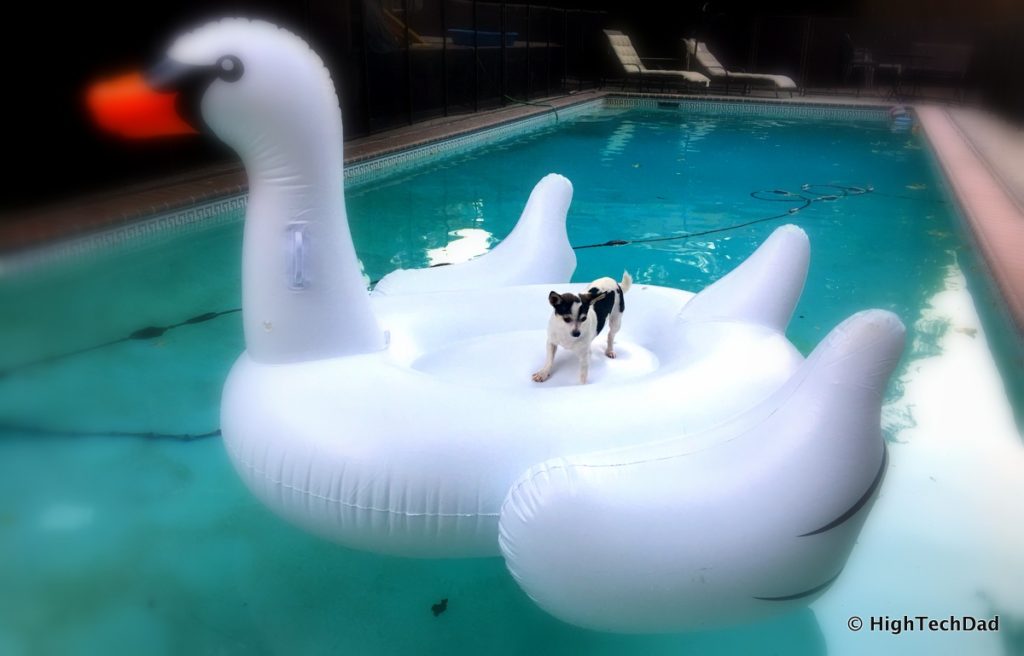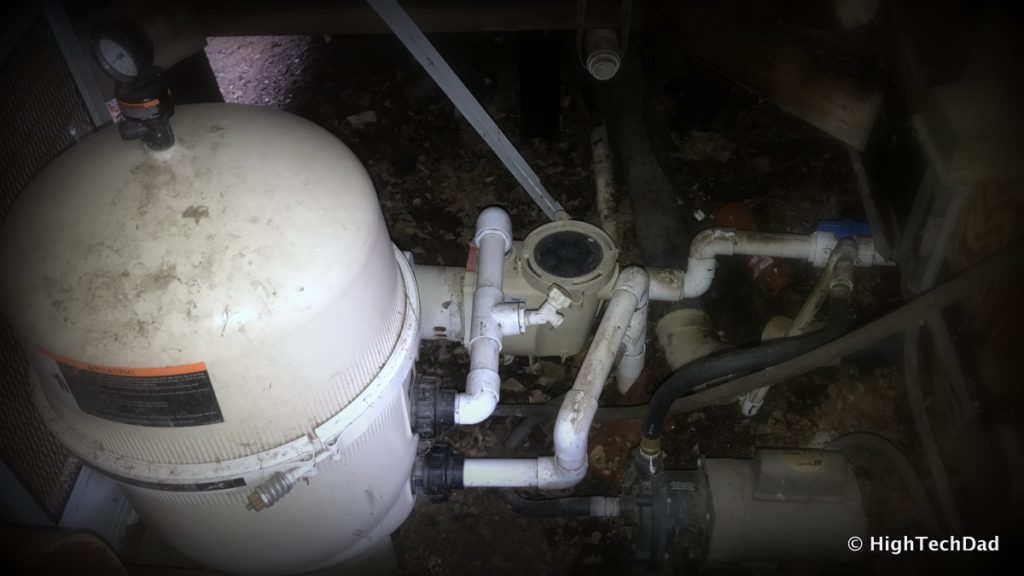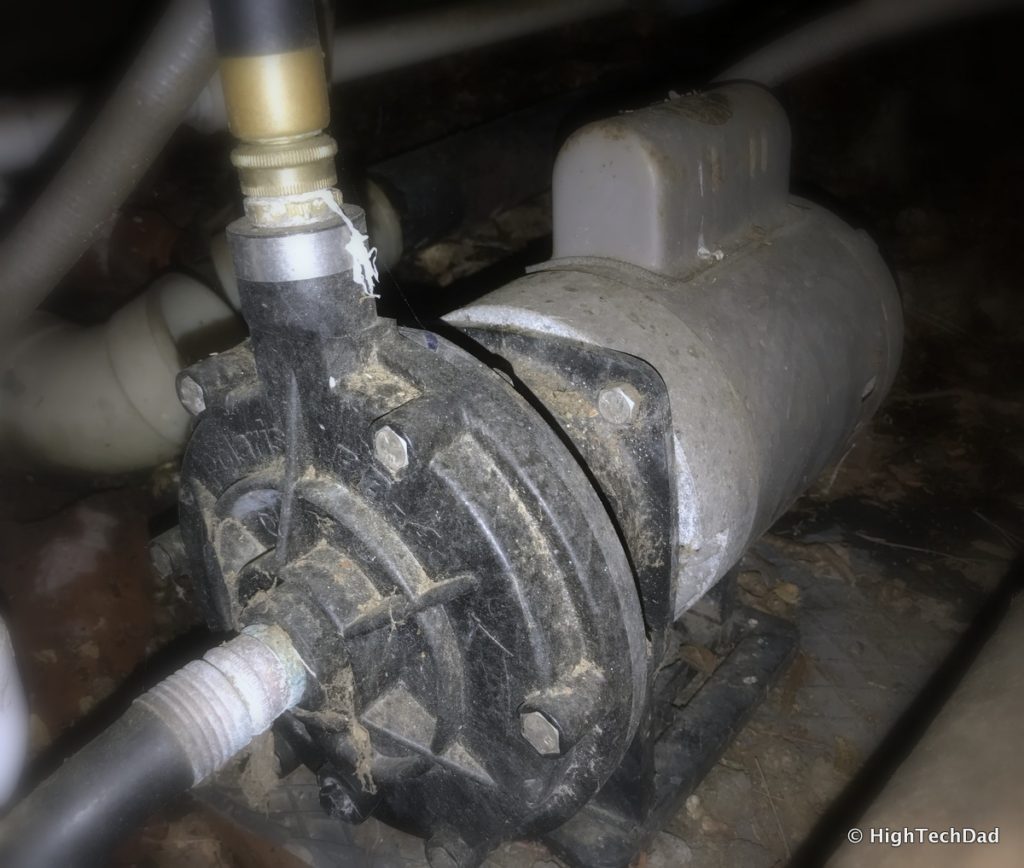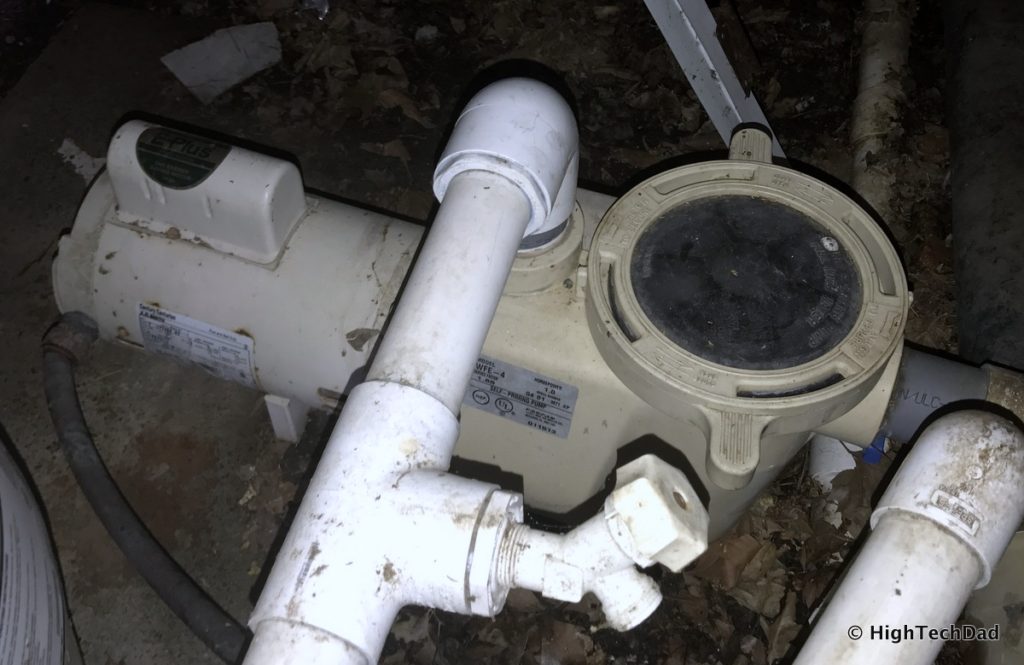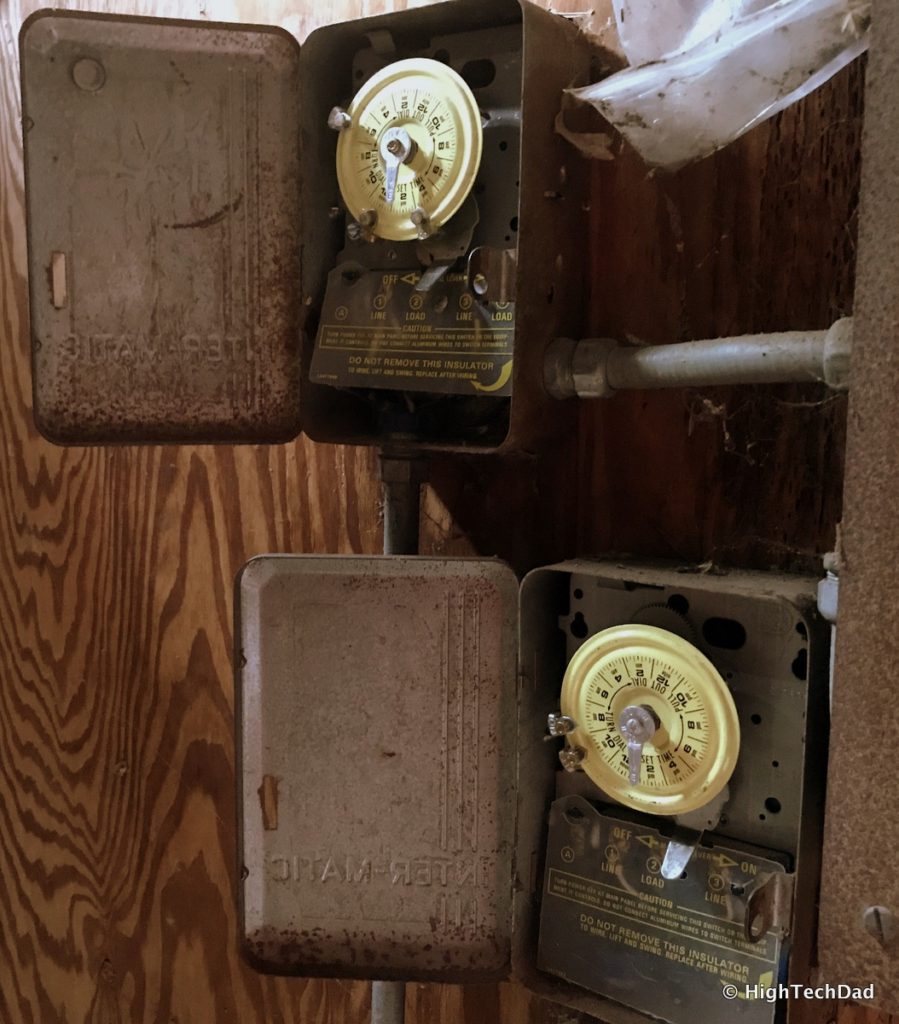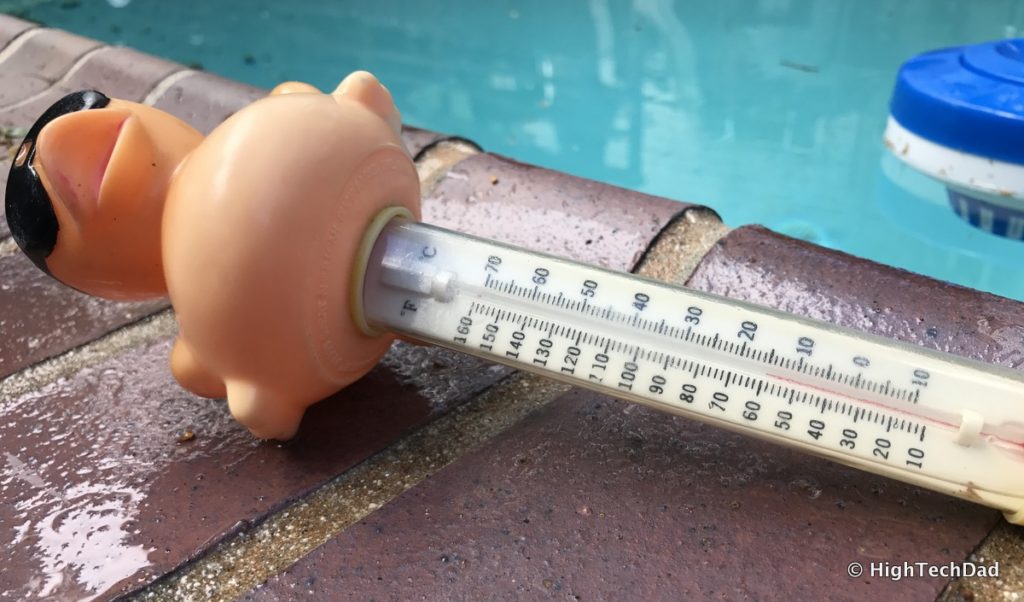Last year, I wrote about a Polaris Pool Sweep that for the past few months has been doing an incredible job getting all of the leaves and debris off of the bottom of my swimming pool automagically. My kids were no longer scared by dark objects like leaves hugging the bottom. Consequently, they started using the swimming pool a bit more, but not to the level I thought they should be. But while my pool has been glistening clean, I have become aware of some other issues.
While the pool sweep was keeping my pool clean, I learned that using old and outdated equipment can be costly…Big time! And not just in terms of money, but also in time spent on a variety of maintenance and usage activities that I have been doing manually. For starters, as I have been beginning to pay closer attention to my home’s energy consumption, I realize my swimming pool currently is not very energy efficient. Also, I only have some manual controls of when the pumps turn on and off.
And I know that I’m not alone here. There are plenty of swimming pool owners with old equipment that are probably not getting the true benefits and enjoyment that they really should be. Let me explain.
There is nothing worse than regularly maintaining and putting money into something then not really using it. I always think about the others things I could spend more time and money on (like a vacation J). Inefficiency of time and energy is a tremendous waste.
So, I decided to learn more about what I could do about it.
Not all pool systems are created equally and as it turns out, my system was closer to riding a bicycle with oval wheels than it was a high-performance sports car. It’s not just that my equipment was old, it’s that the technology in pool equipment has advanced so much to make owning and maintaining a pool much less of a hassle. I always thought as long as the pump turned on and the water was clean, that’s all I could hope for. As I found out, that couldn’t be further from the truth.
I would like to walk through some of the things that I have learned through a variety of research that I have done recently.
Energy Consumption
When we purchased our home many years ago, I was shocked at how much our energy bills (particularly electrical) were. We average anywhere between $250 and $500 a month. And while I initially blamed my kids on leaving on the lights (I know, bad dad) or having non-energy efficient appliances, it turns out it was related to the swimming pool.
To have a “healthy” pool, you need to fully circulate all the water daily. Some people even say you should cycle twice the volume in a day. There is a formula to figure out how long you need to have your pool pump running to effectively do this. Basically, you take your pool’s volume and divide it by the filtration rate and take that number and multiply by 2. That will give you the total hours your pool filter should run.
That means that for larger pools or pools whose systems weren’t designed for its size, you could have your pump running for many, many hours.
Couple that with the need to sweep the bottom of the pool (if your pumps support that) with a pool sweep, and suddenly you have two pump motors running for several hours a day. All that electricity adds up!
For my pool with my system, my pool pump runs from about 7:30 am and runs until 1:30 pm. That’s 6 hours (and probably just the bare minimum). The pool sweep pump runs from 10 am to 11:30 am which is a second pump running about 1.5 hours.
I recently installed an energy meter in my home’s electrical panel so that I can know what devices are on at what time and how much energy they are consuming. I learned that a huge bulk of my daily electrical consumption is coming from these pumps. My main pump, I estimated, is consuming 2000 watts when on. And my second pump (the booster pump) for the sweep is another 500 watts.
That’s a lot of electricity!
So, I wanted to find ways to potentially reduce that electrical cost. As I was reviewing some tools available via my gas and electrical provider, I learned that I could save money by changing the rate plan to one that was based on the time-of-day. So, if were to make sure that my pool pumps were only on during off-peak hours, I could potentially save a bit of money. (There are other energy-saving tips for pools that you can do as well.)
But another thing I learned was that the type of pool pump I was using to circulate the water in my pool is no longer allowed because it is highly inefficient! I have a single-stage pump. Basically, it is either ON or OFF. Full throttle or nothing at all.
There are more highly efficient pumps now available that can save a considerable amount of energy. These are called variable-speed pumps. A variable-speed pump still circulates the required amount of water but does it much more efficiently. For example, during the night, you probably don’t need to circulate as much water so the pump could be set to run at a lower level. During the day, it could be set to a higher level, but still set to only be on during off-peak electrical rate times.
Also, if you have a pool heater, you don’t need to force the hotter water through at full blast. You can use a lower level on the motor to just circulate the heated water. A single-speed pump will just push through the water at the same speed, regardless of the type of circulation that is actually required.
Swimming pool technology has evolved since I got my pool. It’s become much smarter. And I realized that I’m totally living in the past with my current (old) pool equipment, and wasting a lot of money and energy in the process.
Learning Point #1 – Get a good rate plan for your pool and time the equipment accordingly.
Learning Point #2 – Single-speed pumps are highly inefficient. Variable-speed pumps can save up to 90% in comparison.
Swimming Pool Automation
As I looked at my current pool equipment, I realized that it was basically technology from decades ago. There are two timers that I have and they are old-school! These are two metal dials that as they move, turn on or off the pool pump and the pool sweep pump. You manually set them to go on or off. While it does work and has for many decades, it is very inflexible. If you want to change the time or turn on or off the pumps manually, you must physically go down to the timers and flip some switches by hand. And while I don’t have a pool heater, if I did, again, it would be a manual process of walking down to the equipment to start circulating the water when the heater was on.
I hate this. Especially since I have automation throughout my smart home from lighting to thermostats and more. My pool is currently stuck in the 1970’s (probably when that equipment was initially installed).
Again, as I have been researching smart homes and home automation, I have learned that there is a lot more I could be doing with my pool’s equipment. You can control when your pumps run, when you want the heat to kick in, if you want lights to turn on and when, if you want to boost or lower the chlorine levels, and more. This can be all automated, or, even better, remotely triggered using a mobile application.
There is NO WAY I can do this currently. And, being a “HighTechDad” this frustrates me.
Think of this scenario. My kids want to have a night time summer pool party. They want the pool to be warm and clean. So, right now, forget about the warm part (remember, I don’t have a heater). But let’s say it is a hot night. Prior to the party (and probably after it as well), I would want to be sure that the water is fully circulated and chlorinated. I would also have to turn on my pool sweep manually and manually skim some of the leaves of the surface of the pool. And then when the party starts, I would have to go down and manually flip a switch to turn on the pool lights. What word is repeated here? Manually.
With a pool automation system, all of this could be either programmatically or remotely controlled. Using my smartphone (and if I had a heater), I could start heating the water and circulate it a few hours before the party so that the water temperature was at the heated level by the time of the party. Then I could potentially use some sort of an integrated water sanitizer to boost the levels. Then I could have some cool LED colored lighting turn on during the party, and after the party, continue the circulation of the water to filter it while turning off the heating. The key word missing here is, again, manually. It can be all automated or remotely triggered.
Maybe because our pool is still stuck in the 1970’s, our pool parties are far and few between.
Learning Point #3 – Swimming pool automation makes your life easier.
Learning Point #4 – Pool automation can increase the efficiency of your pool equipment, saving you $$$
Warming the Water
But the best way to increase the return on our pool investment is to be able to use it year-round! Because it is a large pool (I have estimated it is 21,000 gallons), it takes a lot of energy to warm it. And the only energy that I can use currently is that glowing orb in the sky. But I don’t have solar heating, so I just need to wait for lots of sunlight and warm air to…verrrrryyyy slooooowly… warm up the water.
Usually, by the time the water it somewhat warm, it is already the end of August and the kids are back at school. I’m guessing last summer, the pool was only used about 10-20 days total. (And it wasn’t used any other time outside of summer.) My estimates $200/month for electrical and $120/month for pool servicing means about $320 per month for the pool = $3840 per year. So, at 10 swims, each swim was $384! Those are some expensive swims. It would be cheaper for me to join a community pool.
But we love our pool and the fact that it is private in our backyard. So truly, the only way to lower that per swim cost would be to both increase the number of swims and/or reduce the costs. As I mentioned before, a variable-speed pump would help reduce the electrical costs. But a pool heater would increase the likelihood that people would swim because the water would be warmer. (But yes, there is the new cost of gas heating – but gas rates are much less than electrical so I figure the offset between electrical savings and gas increase would still hopefully favor an overall energy savings.)
But one thing that is hard to factor in is the enjoyment level and the amount of time actually in the pool. With a cold pool, most of the time is spent jumping in and quickly scrambling out. Or just floating around on the surface. With a warm pool, swims are longer and much more enjoyable. How do you put a monetary value on that?
Natural gas heaters have become much more efficient than before. When we moved into our home about a decade ago, there was an old (disconnected) gas heater in the pool shed. We had it removed because it was simply taking up space. I had heard horror stories about heating pools in the past costing an arm and a leg. But as I did research into new gas pool heaters, there are some that offer 95% energy efficiency.
Also, many gas pool heaters can be connected to pool automation systems and/or smartphone apps (as I mentioned in the previous section).
You can, of course, add various types of solar heating which is something that I have also been considering. There are other heating options as well.
Learning Point #5 – A cold pool reduces the enjoyment factor, the pool uses, and the time spent in the pool.
Learning Point #6 – A heated pool is not necessarily more expensive, especially if you calculate the per swim costs.
My Swimming Pool is Stuck in the 70’s
So yeah, what I have learned through my research and my evaluation of my current (old) pool equipment is that it is highly inefficient, very “dumb,” and consequently causing my family and friends to NOT use it, all at my expense. While I have taken the first step at potentially reducing my energy costs by using a “time-of-day” electric rate, there is still a lot more that could be done.
In the end, having a swimming pool is luxury and if it is underutilized for entertainment or even exercise, can be possibly viewed as a waste. Pool parties and pool fun are things that childhood memories are made of, and I feel that by not improving my pool’s state, I’m depriving my kids of endless hours of summer (and potentially year-round) fun and enjoyment!
For now, I guess I can only hope for a super-hot summer, forcing my family to once and a while jump into our pool for a quick cool off. At least, our pool’s bottom is clean!
Disclosure Text: I have a material connection because I previously received a gift, sample of a product or service, and/or monetary compensation for consideration in preparing to review the product/service and write this content. I was not expected to return this item or gift after my review period. All opinions within this article are my own and are typically not subject to the editorial review from any 3rd party. More information can be found on my About page.
HTD says: There are 3 things to increase enjoyment of a swimming pool: 1) make it energy-efficient, 2) create some automation for it, and 3) heat it up! Those things can drive down costs and drive up the fun!
